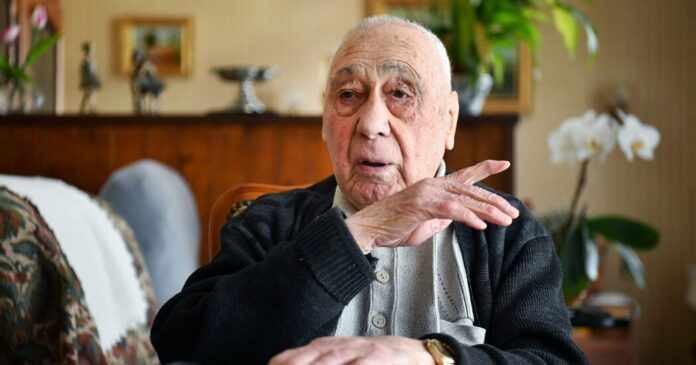Shortly after D-Day during World War II, French resistance fighters took 47 captured German soldiers to a small wooden area in southwest-central France. In the scorching heat, they forced the soldiers to dig their own graves, shot them dead one by one and buried the bodies, covering the remains with quicklime, according to a witness.
The story of the mass execution was concealed from the public for decades, a stain on the heralded resistance movement, until the last-surviving witness broke his silence to a few people — and then revealed it to a global audience in interviews published in recent days.
“We were ashamed,” the witness, Edmond Réveil, who is now 98 and was part of the resistance group, told the French newspaper La Vie Corrézienne. “We knew that we should not kill prisoners.”
French historians have confirmed the general outlines of his story, but his version of events could not be independently verified. His public statements have sent shock waves through the Limousin, a rural area in central France that has long prided itself on its history of resistance during the war and paid a heavy price for it. German Nazi officers from the military arm of the SS, the Waffen-SS, slaughtered hundreds of civilians there in retaliation.
Mr. Réveil, who could not be reached for comment, told the newspaper he had witnessed but did not participate in the killings. He first revealed the grim details in 2019 at a veterans’ meeting. The French and German authorities were informed and planned to exhume the bodies. But the news was mostly kept secret.
“We knew that it was a story that could cause some reactions, some controversies, since it undermines a little of the history of the resistance,” said Philippe Brugère, the mayor of Meymac — where Mr. Réveil now lives and which is near the site of the killings. (The mayor himself had participated in the veterans’ meeting.)
“It was a taboo, a memory we didn’t want to talk about,” Mr. Brugère said.
The French resistance comprised underground organizations that fought the Nazi occupation of France and the collaborationist Vichy regime, playing a key role in the liberation of the country. In the Limousin, they attacked and sabotaged German troops, ultimately freeing the area by the end of summer 1944.
After France was liberated, Mr. Réveil joined the regular French Army and went on to fight in Germany. He then became a rail worker, married and had several children.
The execution of German soldiers followed French resistance groups’ liberation of the town of Tulle after two days of intensive fighting in June 1944. Some 50 Germans were taken prisoner and turned over to Mr. Réveil’s detachment, he said in a 2020 recorded conversation with Mr. Brugère that was shared with The New York Times.
“We couldn’t keep them,” Mr. Réveil said of the captured, explaining that the resistance group did not have enough food and that it was difficult to properly guard so many prisoners at once.
Then, Mr. Réveil says in the recording, his detachment got the order to kill the prisoners from the leadership of the French Liberation Army. But that remains uncertain, according to Xavier Kompa, head of the local branch of the National Office for Veterans.
Mr. Réveil said that his group took the prisoners to woods near a hamlet called Le Vert and that his commander, code name Hannibal, asked for volunteers to carry out the killings. Mr. Réveil said he and a few others refused.
Hannibal talked to each prisoner before he or she was shot, Mr. Réveil said. “He cried like a kid when it was time to shoot them, because it’s no fun to shoot someone,” Mr. Réveil added.
Among the prisoners was a Frenchwoman who had allegedly collaborated with the Gestapo. “Nobody wanted to kill her, so they drew lots,” Mr. Réveil said. “It smelled of blood.”
Mr. Réveil said the group decided never to speak of the massacre. He told La Vie Corrézienne that not even his wife and children knew about it.
Mr. Brugère, the mayor, said that people knew only that a group of German soldiers had been taken prisoner and that “suddenly, poof,” the group had vanished.
In 1967, 11 German bodies were exhumed in Le Vert, in what Mr. Brugère described as a discreet operation: No records were kept at the local level, few people heard about it, and the exhumations were halted for unclear reasons.
“We put a lid again on this memory,” he said.
It took another half-century and Mr. Réveil’s revelations for the case to be reopened. Mr. Brugère and Mr. Kompa, from the National Office for Veterans, said they informed the French and German authorities. Further inquiries were delayed because of the pandemic, but are expected to begin again next month.
A team from the German War Graves Commission will use ground-penetrating radar to find the site of the graves, according to the French Defense Ministry. Should the search prove successful, it will be up to Germany to exhume and rebury the bodies.
The Limousin area is remembered for its active resistance movement with several thousand fighters. In response to the uprising in Tulle, which is in the Limousin, a Waffen-SS unit hanged 99 civilians and sent 149 more to the Dachau concentration camp. The same SS unit was involved in the massacre of 643 inhabitants in Oradour-sur-Glane, considered the worst Nazi atrocity in France.
It is unclear whether Mr. Réveil will face any consequences for his revelations. The mayor said that he knew of no investigation into a possible war crime and that although it “could be considered as such under the law,” he saw it as “an unfortunate, tragic act of war” given the circumstances.
In the recorded conversation, Mr. Réveil was asked why he had broken his silence. He said he wanted to “make official” the history of the executions.
“Everybody knows about it,” he said of the veterans’ group and officials, “but nobody talks about it.”


